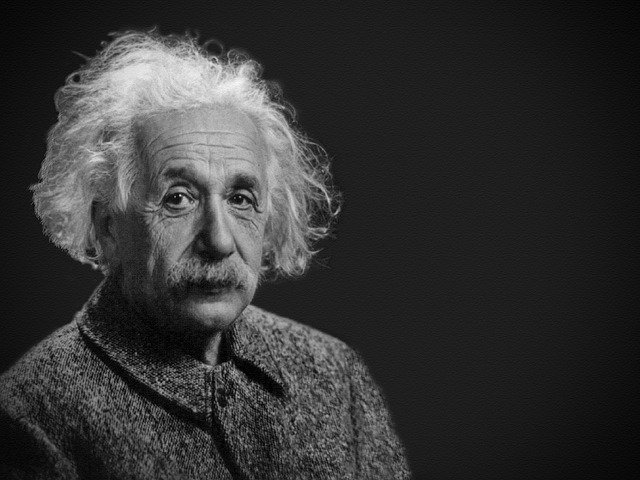In the intellectual corridors of theoretical physics we find those who are gifted with a special capacity for abstract thought. Cooperating and collaborating in the fight to wrest nature’s secrets from her closely guarded bosom, these intellectual gladiators simultaneously compete for “top-dog” status in achieving the breakthrough insight that yields a new paradigm. Anyone who can stand head and shoulders above the members of this intellectually elite group is entitled to be called a “genius.” Albert Einstein did this: not once, but twice, and possibly thrice–what sports fans call a “three-peat.” In this post, we will visit the first of Einstein’s breakthrough insights and will cover the others in a subsequent post.

In August 1900, a 21-year-old student named Albert Einstein graduated in physics from Eidgenössische Technische Hochschule (ETH) in Zurich with a commendable mark of 4.91 out of 6. Since it was customary for students to be offered junior academic appointments upon graduation, Einstein was bitterly disappointed when he was the only one of his graduating friends who was passed over. His independence of thought and his unwillingness to submit to intellectual authority had been perceived as arrogance by his elders, preventing him from winning an academic post.With no means of supporting himself, he desperately sought employment.
On June 16, 1902, after two years of temporary tutoring and teaching jobs, Einstein finally landed a job as an engineer Class III in the Swiss Patent Office in Berne. This “shoemaker’s job”, as he later described it, engaged him in assessing the viability of inventions submitted for patents. In a letter to his friend Conrad Habicht, he wrote, “[This job gives me] besides eight hours of work…eight hours of idleness plus a whole Sunday.” The “idleness” provided by this “shoemaker’s job” would give Einstein the freedom to explore the foundations of physics and reconstruct Newton’s model of the universe.
In 1905, while still toiling as a clerk in the Patent Office, Einstein was awarded a doctorate by the Zurich Physics Institute for his 21-page dissertation, A New Definition of Molecular Dimensions. Though the examining committee had been divided on whether it was “physics” or “mathematics”, a final judgment asserted, “[despite] crudeness in style and slips of the pen in the formulas which can and must be overlooked, …, [the paper displays a] thorough mastery of mathematical methods.”
Achieving a Ph.D. in physics was a relatively minor accomplishment for Einstein in a year that has become known as his annus mirabilis (miracle year). [Recall that Newton’s anni mirabili also occurred in his mid-twenties.] On March 17, 1905, just three days after he turned 26, Einstein submitted to the physics journal Annalen der Physik a paper explaining the photoelectric effect–a paper for which he would eventually receive a Nobel Prize.
Then, on May 11, just two months later, he submitted to that same journal another opus magnum, this time on Brownian motion, explaining how colliding molecules produce the random motion observed when microscopic particles like pollen grains oscillate in water.
Despite the significance of these two papers, they would eventually be eclipsed in importance by a third containing a revolutionary insight captured in his Special Theory of Relativity–an insight that would revolutionize physics irrevocably by challenging Newton’s assumption that space and time are absolute. These three papers, any one of which would have earned Einstein a place among the greatest physicists of all time, appeared in the celebrated Volume 17 of Annalen der Physik in July 1905.
As if this flurry of papers were not enough, on September 27 of the same year, he submitted yet a fourth paper, an “addendum” to his Special Theory of Relativity which was subsequently published in Volume 18. In it, he derived his famous equation E = mc2 that defines his mass-energy equivalence principle and often serves as an icon for the discoverer himself. His counterintuitive assumption that time is not absolute was met with the same skepticism that Galileo and others had faced when promoting ideas that were perceived to be outrageously radical.
It took a couple of decades for the scientific community to accept Special Relativity, and incorporate it into the mainstream of accepted scientific fact. During this period of gradual acceptance, Einstein had been preoccupied with his search for a theory that would unify gravitational and electromagnetic forces. He was oblivious to the fact that experimental verification of his Special Theory had become commonplace among Ph.D. students. Reporting on Einstein’s attendance in 1934 at a Princeton seminar, Professor A. E. Condon wrote:
A graduate student was reporting on researches of this kind and Einstein was in the audience. Einstein…grinned like a small boy and kept saying over and over, “Ist das wirklich so?” (Is it really true?) as more and more specific evidence of his E = mc2 relation was being presented.
While Einstein’s new formulation of the laws of physics was originally met with skepticism, the young scientist powered forward to reformulate the concept of gravity, undaunted by the naysayers. It was this next insight that catapulted Einstein into public awareness and bestowed on him the indisputable title of “genius.” Stay tuned for that episode. A more in-depth look at Einstein’s accomplishments can be found at: https://www.intelligence-and-iq.com/chapter-1-the-many-faces-of-intelligence/
